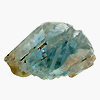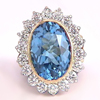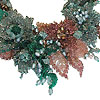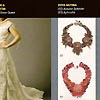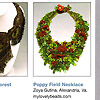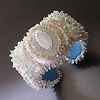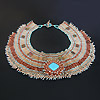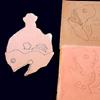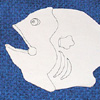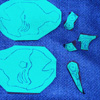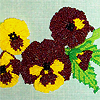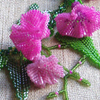December, 2008

Happy holidays!The holiday season is for family gatherings, fattening goodies, and flickering lights. Enjoy the season because before you know it, the year will be through. We love you all! In the final issue of 2008 year:
Blue topaz
Beadwork exhibition in Moscow Our achievements in 2008 Featured artist - Triz New Dimensions in Beadwork. Part 2 Beaded flower garden by Svetlana Free tutorials on MyLovelyBeads.com January upcoming events Again, happy holidays!
MyLovelyBeads.com Team |
|
|
|
Blue topazTopaz is a precious stone. Pure topaz is colorless and transparent but is usually tinted by impurities; typical topaz is wine or straw-yellow, pale gray, or pink. They may be made white, gray, green, blue, pink or reddish-yellow and transparent or translucent. The name "topaz" is derived from the Greek TOPASIOS, the author of one of the first systematic treatises on minerals and gemstones dedicated two chapters on the topic in 1652. In the Middle Ages the name Topaz was used to refer to any yellow gemstone. Topaz may be found with fluorite and cassiterite. It can be found in the Ural and Ilmen mountains (Russia), Afghanistan, Sri Lanka, Czech Republic, Germany, Norway, Pakistan, Italy, Sweden, Japan, Brazil, Mexico, Flinders Island and the United States. Some clear topaz crystals from Brazilian pegmatites can reach boulder size and weigh hundreds of pounds. Crystals of this size may be seen in museum collections. The famous Braganza diamond is in most likelihood a topaz. The topaz of Aurungzebe, observed by Jean Baptiste Tavernier measured 157.75 carats. Colorless and light-blue varieties of topaz are found in Mason County, Texas, but there is no commercial mining of topaz in that area. Blue topaz is a December birthstone, read about another December gem, turquoise, in our last year's December issue. Blue topaz is the Texas state gemstone, often cut with the Lone Star cut - the Texas state gemstone cut showing a star in the heart of the gem. The Texas Natural Science Center exhibits a 1778 carat blue topaz found in a Brazilian mine. Topaz very rarely occurs blue naturally. Typically, colorless, gray or pale yellow material is heat treated and irradiated in order to turn it blue. There are are several varieties of blue topaz common to the jewelry industry:
• Sky blue topaz, often simply called "blue topaz", it is
the most common seen in jewelry. Its color is fairly similar to
that of top-quality aquamarine, but without aquamarine's gray
components. Its also available in a wide range of sizes.
• Swiss blue topaz, which has a electric blue appearance.
It has a more saturated color than sky blue topaz.
• London blue topaz, which is a deep steely grayish blue
color. It is the darkest non-coated variety available on the market.
Its name does not imply its origin.
|
|
Beadwork exhibition in Moscow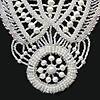
Recently Svetlana Eltsova, a beaded jewelry designer from Finland, has participated in the Glass Bead Expo 2008 Exhibition ("StekloBiserExpo-2008"), that took place in Moscow. When she returned home she wrote an article for our newsletter about that exciting event. We think, it will be interesting to read how beadart is being developed in Russia today. Svetlana says, "The fair and exhibition activity is one of the most important instruments of beadwork promotion in Russia, especially nowadays, when interests in crafts, folk art and ethnic culture is on the increase not only among the Russian people seeking their "roots" after the Soviet Union collapsed, but among other ethnic groups of the former USSR. 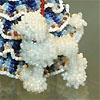
Although bead weaving or threaded beadwork in Russia has a long history, there was time when it almost turned into a forgotten craft in the last century. The renaissance of the "lost" bead craft in Russia started about ten years ago partly thanks to "Wonderful Moments of Beading" magazine ("Chudesnye Mgnoveniya") and the "Fashion Beadwork" magazine ("Modny Biser"), which have been doing their best to popularize beadwork in Russia again. A number of wonderful beading books published over the last ten years also spur interest in that craft. The Internet united Russian speaking beaders from all over the world into a huge informal virtual association, it is now much easier to see what fellow beaders are working on, listen in on the latest buzz, find inspiration for the own upcoming projects and etc.. 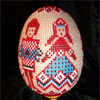
"New Wave" beadworkers are eager to share the design ideas, participate in the shows and receive the first invaluable experience of exhibiting. Thanks to the Russian Glass & Glazing Association ("StekloSoyuz") and the Ministry of Culture of the Russian Federation for holding and supporting, the First International fashion accessories, home decor and beaded jewelry exhibition fair, Glass Bead Expo 2008 ("StekloBiserExpo-2008") took place in Moscow on December 10-12, 2008. The exhibition was based on the idea to gather bead artists, experienced beaded jewelry designers and talented beginning jewelry makers, as well, under one roof within a common exhibition space and provide them all with a unique chance to share their brilliant ideas with each other, and get an overall view on most recent trends in beaded jewelry making. More than 45 exhibitors from Russia, near and far abroad, including Ukraine, Belarus, Greece, Finland and the US participated in "StekloBiserExpo-2008". 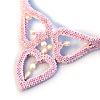
Among the artists who have taken part in the exhibition were such talented Russian beaded jewelry designers and makers as: Elena Vilchevskaya, Galina Pchelkina, Natalia Busheva, Olga Makhonova, Galina Grebenschikova, Elena Barsukova-Graphkina, Alla Maslennikova, Nella Moskvicheva, Natalia Berezovskaya, Olga Boltenkova, known beaders from Moscow, Nizhny Novgorod, Samara, Belgorod, Rostov-on-Don and other places. "StekloBiserExpo-2008" became a really true festival for both visitors and participants, as they were able to see wearable and non-wearable artworks, meet the artists working in various techniques, and have long chats. All genres of bead weaving were on display: beaded paintings, beaded Russian icons and Easter eggs, beaded trees, flowers, sculptures and toys, and beaded jewelry, of course." The full article on Glass Bead Expo 2008 Exhibition Pictures from Glass Bead Expo 2008: |
|
Our achievements in 2008 |
|
Featured artist - Triz
Interview with beadwork artist Patrizia Tager Our guest today is incredibly talented bead artist from Israel Patrizia Tager (Triz), she was very kind and agreed to answer our questions. We believe that you'll be glad to know Patrizia and read her short story on her passion, the name of which is beading! 1. Triz, where are you from and where do you live now? I was born in Milan, Italy where I lived till I was twelve. My mother is French and my father is British, and when I was 12 my family moved "back" to England. After graduating from college at the age of 22, I decided to move to warmer climates, as I cannot stand cold and rainy weather, so I moved to Israel, where the sun shines eleven months of the year. I'm still in Israel today. 2. What is your education and occupation? I graduated with a B.A. Hons in Fashion Design from the American College in London (renamed The American Intercontinental University, London). I studied photography for two years in Israel and then in my perpetual quest to find myself, I went on to study Social Policy and Criminal Justice. I currently work as a desktop publisher for a medico-legal publishing house as well as working on my own beadwork and teaching intermediate/advance bead embroidery workshops. 3. When did you start crafting and what was your first craft? This is so difficult to answer! I've always, as far as I can remember, been doing one form of craft or another. This is mainly due to the wonderful nanny, Paola, that looked after my sisters and I when we were little. She was with us for many years and was incredibly talented and resourceful. We used to make hand puppets and create the most beautifully decorated puppet theatres all made out of cardboard boxes. She also taught me to knit and to crochet and, in fact, introduced me to my early experience with beadwork by showing me how to make a loom out of a shoe box and taught me to make loom-woven beaded bracelets. Coming from a completely artistically-challenged family, she was my artistic angel sent from above. She encouraged, praised and inspired me. 4. How did you come to beading? What inspired you? As I mentioned above, I was introduced to beading by our nanny Paola, however those days were long forgotten once I moved to London and it wasn't until about 3.5 years ago that I was reintroduced to this wonderful world of beads. When my son turned one and started attending day-care a couple of times per week, I found myself desperate to get out of the house for a few hours and do something creative. The local shopping center had a beading shop and I went in to enquire about taking some classes. I took four basic beading classes, where I learnt to make a beaded ball and a couple of other beginner's projects. I became completely and utterly hooked with this medium. It was as though I found myself, finally! The four classes weren't enough, I desperately wanted more, so I went out and bought every magazine and book I could find on beadweaving and for a year I spent all of my free time trying out different techniques. It became my true passion verging on obsession.
Full interview with Patrizia Tager
|
|
New Dimensions in Beadwork. Part 2
Today we publish the second and the last part of the Andrea Landau's article "New Dimensions in Beadwork - An Overview of Bead Sculpture", the first part you can read in our November's issue. Again, thank you, dear Andrea, for sharing with us your thoughts of beadwoven and bead embroidered sculptures, of the creative process - how to make beaded sculptures! We wish you a Merry Christmas and a Happy New Year! Chapter 3. Preparing your Pattern OK, so you have selected your subject, have him sketched out, have supplies and are ready to go. Nope! Almost, but not yet. Trace your sketch on tracing paper, including all of the details, cut it out and attach to poster board. This is your main template. Below are my initial sketches of my fish, to the left my main template (photo 1). Take a good look at your sketch. We are taking this 3D, so why not extreme 3D? Real-life 3D? Let's do it! I'll show you what I did for that in regard to my fish, you'll have to evaluate your subject to see what you can do where to make the whole thing more interesting (photo 2). As you can see, I broke my sketch down into pieces, and attached the pieces to poster board for template purposes. The fin is self-explanatory, it was constructed and later attached, and sticks out like a fin is supposed to. The curved pieces are gills, and I also decided to add emphasis to the head area so I made a separate head template (photo 3). I wanted to raise the gills above the rest of the beadwork, so I made them separately. I decided I wanted to stuff the head part even though the entire fish was destined to be stuffed, to add more interest and dimension to the sculpture. The only other skills required are necessary for both beadwoven and embroidered sculptures and have nothing to do with beads, but with the artist's ability to make their sculpture resemble the original idea. If making an abstract sculpture, the only limits are those imposed by the artist. If on the other hand the idea is to produce a lifelike replica of something, the artist will need to have some basic skills in sculpture and or drawing... a good rule of thumb is that if you can sketch something lifelike from more than one angle without having to trace, then you can produce a lifelike beadwoven sculpture. Those who don't have drawing skills can opt for a stylized bead sculpture, which affords more room for personal artistic expression. The bottom curve of the head next to the gills was treated (and decorated differently from the rest of the head - with bugle beads) as another gill, and sits above the rest of the beadwork while the rest of the head is tacked down. I'll show you my solution for the gills further on. As you can see, you can easily find elements even in a simple subject that you can play with according to your creativity to add emphasis to a specific area, or simply to add more interest to the whole. Once you've singled out which parts you want to treat differently, take another piece of tracing paper and trace them directly from the template. Cut them out and attach them to cardboard. Now you're ready to trace your various pattern pieces onto your felt, and only a breath away from picking up those dang beads, because I know you're busting a gut by now!
Read the full Part 2 of the article
|
|
Beaded flower garden by Svetlana
Svetlana Eltsova, 46, born Russian spent her childhood in the deep Ural country side next to Tyumen town, the main Siberian oil region center. Her paternal grandmother taught her many crafts including knitting, crochet and sewing. But she gave up all of them after finishing school and entering Sverdlovsk (now Yekaterinburg) Pedagogical Institute. She wanted to know languages, that's why Svetlana choose the faculty of foreign languages, where she studied German and English for 5 years. After graduating from the institute she taught languages to children in the secondary school in Tyumen. One day her school colleague boasted of beaded Easter eggs made by her own. The beadwork impressed Svetlana so much, that next day she went to the book store to buy any beading book and teach herself beading stitches and techniques. Now her craft background includes all basic techniques and stitches: peyote, brick stitch, netting, Ndebele (herringbone) and square stitch. Svetlana is creating off-loom jewelry pieces. All her bead pieces are inspired by the beauty of flowers and plants growing in the area, where she lives. Svetlana says, that each time she watches a flower or a leaf, she tries to translate those images in her mind to a beaded piece for her neck or wrists. In her botanical beaded jewelry collection you can find chamomiles, marigolds, pansies, lilac, red current berries, snowdrops and snowberries and other local flora examples, as well. "Everything started with pansy flowers", Svetlana has confessed. Her first floral neckpiece "Pansies" was made after Diana Fitzgerald's tutorial. The necklace was so pretty, that Sveta decided to write a Thank You letter to D. Fitzgerald and was very happy when the bead art master answered it. As people say "The ability to give strokes is a skill". So Diana Fitzgerald was that person, who gave Svetlana a stroke. Her warm compliments fired a beginning beaded jewelry maker to create something else. Svetlana ordered some books to learn more about 3-D flowers, in particular, "The Trumpet Flower" by Marcia Katz, "Spring Riot" by Cindy Fleming, "Dimensional Flowers, Leaves & Vines" by Barbara L.Grainger, "The Beader's Floral" by Liz Thornton and Jill Devon. While corresponding with B.L.Grainger related to the book order, Svetlana promised the bead artist to show any necklace, she would later create after her instructions and tutorials. Sveta kept her word. She learnt to brick stitch a morning glory flower and a year later created a "Morning Glory" necklace. The photo of the neckpiece was sent to Barbara, who replied as follows: "...Your Morning Glory necklace is just beautiful! I love the colors you used. It's so wonderful to see how you have taken the flower and created your own necklace. That was the reason I wrote the book - so people could take the flowers and leaves create their own works of art..." Svetlana also adores floral jewelry made by Karen Paust, Huib Peterson and Margo Field, as well. Now Svetlana is designing her own leaves and petals for her dimensional flowers, but each time she faces problems, she opens the beader's floral books and usually finds a solution. In 2007 Svetlana Eltsova joined the Beadworkers Guild (UK) and since then actively participates in the BWG annual challenges.
Beaded flower garden by Svetlana Eltsova
|
|
Free tutorials on MyLovelyBeads.comFor those of you who want to try jewelry making - free tutorials on MyLovelyBeads.com:
How to make: Soutache and Beads Bracelet
How to make: Beaded Raspberry How to make: Christmas Tree How to make: Gerbera Flowers How to make: Russian Leaves How to make: Simple Stud Earrings How to make: Squares Bracelet How to make: Starflower Earrings |
|
Upcoming events
January 30-31, February, 1, 2008 Juried Fine Art & Craft Festivals since 1976. Find the unique handcrafted artwork of thousands of American Artists! Decorative creations for home & garden, exceptional fine art & designer crafts! |
|
NoteIf you don't see the newsletter properly formatted please click here: December Issue |
© 2010 MyLovelyBeads.com All Rights Reserved.
If you do not want receive our newsletter and you wish to remove your email address from our mailing list, please click the following link to unsubscribe.



